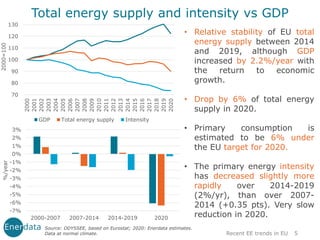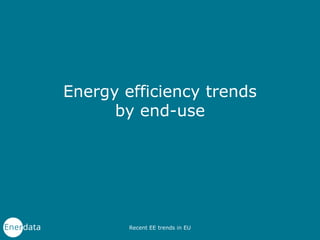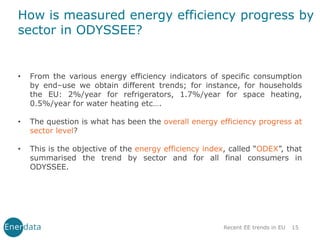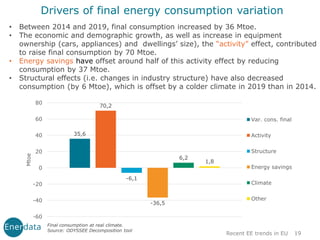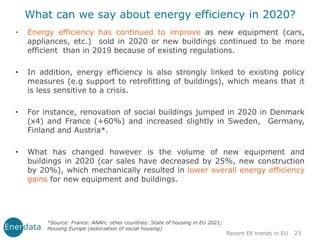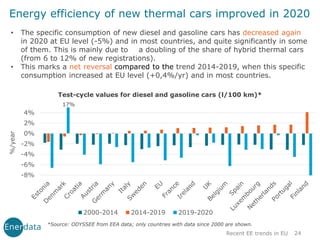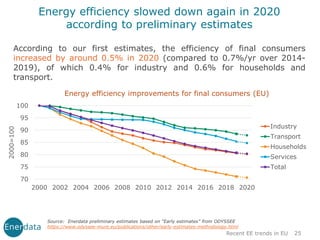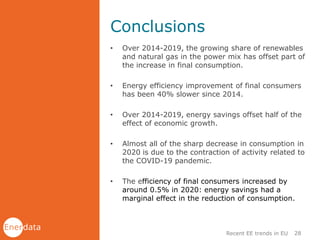Recent energy efficiency trends in the EU
- 1. Odyssee-Mure webinar series on Energy Efficiency organised by Leonardo ENERGY November 30th, 2021 Bruno Lapillonne, Laura Sudries – Enerdata with Estelle Payan - Enerdata Recent energy efficiency trends in the EU
- 2. ▪ This webinar is organized in the framework of the ODYSSEE-MURE project, that is supported by the H2020 programme of the European Commission. The project is coordinated by ADEME, with the support of Enerdata and Fraunhofer-ISI. www.odyssee-mure.eu ▪ The webinar relies on data and energy efficiency indicators prepared in the framework of the project and disseminated in a database, called ODYSSEE, and in 5 data tools. ▪ ODYSSEE covers 31 countries*. It is updated up to 2019 from national sources and completed by Enerdata with early estimates for 2020**. ▪ EU corresponds to EU27 (i.e. without the UK) 2 * 27 EU Member States + UK, Norway, Serbia and Switzerland ** See methodology at https://www.odyssee-mure.eu/publications/other/early-estimates- methodology.html Recent EE trends in EU About
- 3. Outline ▪ Energy consumption trends ▪ Energy efficiency trends by end-use ▪ Energy efficiency trends by sector ▪ What can we say on energy efficiency in 2020? ▪ Conclusions 3 Recent EE trends in EU
- 4. Energy consumption trends Recent EE trends in EU
- 5. • Relative stability of EU total energy supply between 2014 and 2019, although GDP increased by 2.2%/year with the return to economic growth. • Drop by 6% of total energy supply in 2020. • Primary consumption is estimated to be 6% under the EU target for 2020. • The primary energy intensity has decreased slightly more rapidly over 2014-2019 (2%/yr), than over 2007- 2014 (+0.35 pts). Very slow reduction in 2020. Total energy supply and intensity vs GDP Source: ODYSSEE, based on Eurostat; 2020: Enerdata estimates. Data at normal climate. 5 Recent EE trends in EU 70 80 90 100 110 120 130 2000 2001 2002 2003 2004 2005 2006 2007 2008 2009 2010 2011 2012 2013 2014 2015 2016 2017 2018 2019 2020 2000=100 -7% -6% -5% -4% -3% -2% -1% 0% 1% 2% 3% 2000-2007 2007-2014 2014-2019 2020 %/year GDP Total energy supply Intensity
- 6. • Between 2014 and 2019, total energy supply increased less than final consumption: 17 Mtoe compared to 36 Mtoe. • This lower progression was explained by changes in the power mix, with: • A higher share of renewables (+4 pts) and a lower share of nuclear (-2 pts) and thermal (-2 pts) that reduced total energy supply increase by 18 Mtoe. • An improved efficiency of thermal generation (+2.2 pts) with a shift from coal to gas, which contributed to a reduction of 19 Mtoe. • In 2020, a similar phenomenon occurred: total energy supply decreased more than final consumption because of an increased penetration of solar and wind (+4 pts). 6 Drivers of total energy supply variation over 2014-2019 Total energy supply vs final consumption Recent EE trends in EU Source: ODYSSEE Decomposition tool 1396 + 36 + 9 - 19 - 18 + 7 + 2 - 1 1412 1350 1400 1450 2014 Var. final cons. Electricity penetration Efficiency thermal power plants Power mix Var. ambient heat Other transf. Non energy uses 2019 Mtoe
- 7. • Final energy consumption grew again between 2014 and 2019 with the economic rebound (+0.7%/yr), in sharp contrast with total energy supply trends. • Electricity consumption growth was 3 times slower (0.6%/yr) than before the financial crisis. • Transport was the most dynamic sector over 2014-2019 and was back to the trend before 2007 (1.4%/yr). • Industry had the lowest progression (0.3%/yr). Recent EE trends in EU 7 Total Electricity Final energy consumption trends until 2019 -3% -2% -1% 0% 1% 2% 3% %/year 2000-2007 2007-2014 2014-2019 2000-2007 2007-2014 2014-2019 Households and services at normal climate. *Services include non-specified. Source: ODYSSEE
- 8. • Final consumption dropped by 5.6% in 2020 and electricity consumption by 4.5%. • Transport was the most impacted sector, due to lock down and travel restrictions (-11%). • Services registered the highest decrease in electricity consumption (-7%) due to massive teleworking and temporary closure of many public-access establishments (shops, bars, restaurants, etc.). • Households was the only sector consumption with an increase in consumption with people staying longer at home (+1.4% for total, +1.9% for electricity). Source: Enerdata estimates. International aviation excluded. Households and services at normal climate. Recent EE trends in EU 8 Total Electricity Impact of 2020 crisis on energy consumption -12% -10% -8% -6% -4% -2% 0% 2% %/year
- 9. Energy efficiency trends by end-use Recent EE trends in EU
- 10. 10 How is measured energy efficiency progress by end-use in ODYSSEE? • Energy efficiency progress is measured by end-use or sub sector with various indicators of specific consumption measured in physical units selected to be as as close as possible to energy efficiency: • For transport in l/100 km or koe/pkm for cars, in l/100 km and koe/tkm for trucks, etc. • For households in toe/m2 for heating, in kWh/appliance for large appliances, in toe/dwelling for cooking or water heating, etc. • For industry in toe/ton for energy intensive products (steel, cement, pulp and paper), in toe/IPI for other branches. • Trends observed for three end–uses will be presented now: cars, household space heating and large appliances. • More indicators can be found in the “key indicator tool” at https://www.indicators.odyssee-mure.eu/online-indicators.html Recent EE trends in EU
- 11. Energy efficiency trends of new cars 11 0 1 2 3 4 5 6 7 8 9 l/100km 2000 2014 2019 • Reduction in the specific consumption of new diesel and gasoline cars until 2014 (1.8%/yr). • Reverse trend since then in most countries and net slowdown in the others, due to two main factors: a decrease in diesel share (-20 pts at EU level) and a growing share of SUV (+ 15 pts). • Much lower efficiency progress for the car stock, in koe/pkm (0.3%/yr), for several reasons: biofuels, occupancy rate and real driving conditions (actual l/100 km higher than test values). Source: ODYSSEE, based on test specific emissions from EEA Specific consumption of new cars (test values) Recent EE trends in EU
- 12. Energy efficiency of household heating? 12 Recent EE trends in EU • The specific consumption per m2 for households heating has decreased rapidly in almost all countries since 2000 (-1.7%/year on average in the EU). • This trend has significantly slowed down since 2014 at EU level (-0.6%/yr vs - 2.1%/yr before), and in several large countries (e.g. France, Netherlands), with even a reversal in Germany; this may come from several factors: • Less new construction (-30% since financial crisis), which only represents each year 0.9% of the stock (i.e. only 9% of new stock after 10 years); • Quality of renovations and construction • Slower diffusion of efficient heating modes (condensing boiler)** • Rebound effect? Unit consumption per m2 for space heating for largest consumers* Source: ODYSSEE based on national data * Countries representing 75% of the EU heating consumption of households (60% for the 4 largest). ** Penetration of efficient heating modes at https://www.indicators.odyssee-mure.eu/market-diffusion.html -4% -3% -2% -1% 0% 1% %/year 2000-2014 2014-2019
- 13. 13 Recent EE trends in EU Energy efficiency trends: large households appliances • The specific consumption of large appliances (measured in kWh per appliance) has decreased steadily since 1990 by the labelling and eco-design regulations. • Efficiency gains are above 40% (i.e. ~2%/year) for refrigerators, washing machines, dish washers and dryers; for freezers, gains are lower, around 37%. Source: ODYSSEE, based on national data Specific energy consumption of large appliances (EU average) 50 55 60 65 70 75 80 85 90 95 100 1990 1991 1992 1993 1994 1995 1996 1997 1998 1999 2000 2001 2002 2003 2004 2005 2006 2007 2008 2009 2010 2011 2012 2013 2014 2015 2016 2017 2018 2019 1990=100 Refrigerators Freezers Washing machines Dishwashers Dryers
- 14. Overall energy efficiency trends and savings by sector Recent EE trends in EU
- 15. 15 How is measured energy efficiency progress by sector in ODYSSEE? • From the various energy efficiency indicators of specific consumption by end–use we obtain different trends; for instance, for households the EU: 2%/year for refrigerators, 1.7%/year for space heating, 0.5%/year for water heating etc…. • The question is what has been the overall energy efficiency progress at sector level? • This is the objective of the energy efficiency index, called “ODEX”, that summarised the trend by sector and for all final consumers in ODYSSEE. Recent EE trends in EU
- 16. How is calculated ODEX? • ODEX is calculated: o First, by expressing trends in specific energy consumption by end-use (or sub-sector), as an index of variation; o Then by calculating an average index for the sector weighted by the share of each end-use (or sub-sector) in the sector’s energy consumption. • ODEX is presently calculated on the basis of ODEX is presently calculated on the basis of up to 40 sub-sectors (8 modes in transport, 11 end-uses for households, 14 branches in industry, 6 branches in services). • The use of index of variation by end-use (or sub-sector) enable to mix specific consumption indicators expressed in different physical units so as to be as close as possible to energy efficiency (e.g. for household: toe/m2 for heating, kWh/dwelling for lighting, kWh/appliance for appliances and cooling, toe/household for water heating and cooking). 16 *For more information on ODEX: https://www.odyssee-mure.eu/publications/archives/odex- indicators-database-definition.html Recent EE trends in EU
- 17. ▪ The energy efficiency progress of final consumers, as measured with ODEX, has slowed down from 1.2%/yr over 2000- 2014 to 0.7%/yr since 2014. ▪ Households is the sector with the greatest progress since 2000, however with improvements twice lower since 2014. ▪ Strong slow down in industry since 2007 (0.8%/yr; down from 1.6%/yr before). ▪ Lowest improvement in transport, with also a progress twice lower since 2014 (0.4%/yr) than over 2007-2014, because of the slower progress for cars. ▪ Larger gains for services since 2010 (1%/yr for services over 2014-2019). Energy efficiency improvements for final consumers (EU) 17 Declining progress in most sectors since 2014 Recent EE trends in EU Source: ODYSSEE, measured with ODEX (Odyssee Energy Efficiency Index). ODEX=81.3 in 2019 ➔ 18.7% energy efficiency improvement since 2000 70 75 80 85 90 95 100 2000 2002 2004 2006 2008 2010 2012 2014 2016 2018 2000=100 Industry Transport Households Services Total
- 18. • Energy savings represented 21% of final energy consumption in 2019: without savings final consumption would have been 21% higher. • Since 2014, these savings have been twice lower for transport and households. • Households were overrepresented, with a share of total savings 50% higher than their share in consumption (44% vs 27%) while savings in transport were twice lower than their share in consumption (15% vs 31%). This is explained by the high number of measures for households. % in energy savings % in final consumption 18 Energy savings vs. consumption 0 20 40 60 80 100 120 140 160 180 200 2000 2001 2002 2003 2004 2005 2006 2007 2008 2009 2010 2011 2012 2013 2014 2015 2016 2017 2018 2019 Mtoe Industry Transport Households Services 28% 31% 27% 14% 31 % 15 % 44 % 10 % Recent EE trends in EU Source: ODYSSEE; cumulated annual energy savings since 2000; https://www.indicators.odyssee-mure.eu/energy-saving.html
- 19. 19 Drivers of final energy consumption variation • Between 2014 and 2019, final consumption increased by 36 Mtoe. • The economic and demographic growth, as well as increase in equipment ownership (cars, appliances) and dwellings’ size), the “activity” effect, contributed to raise final consumption by 70 Mtoe. • Energy savings have offset around half of this activity effect by reducing consumption by 37 Mtoe. • Structural effects (i.e. changes in industry structure) have also decreased consumption (by 6 Mtoe), which is offset by a colder climate in 2019 than in 2014. 35,6 70,2 -6,1 -36,5 6,2 1,8 -60 -40 -20 0 20 40 60 80 Mtoe Var. cons. final Activity Structure Energy savings Climate Other Recent EE trends in EU Final consumption at real climate. Source: ODYSSEE Decomposition tool
- 20. What can we say on energy efficiency in 2020? Recent EE trends in EU
- 21. Energy efficiency in a period of recession: some reminders • In general energy efficiency deteriorates in periods of deep recession in productive sectors (industry, services and freight transport): indeed, energy consumption does not follow the reduction in economic activities because of lower use of industrial capacities, or lower load factor for trucks, leading to an increase of indicators of specific consumption and a lower “efficiency”, not from a technical viewpoint but from an operational viewpoint. • The same applied in 2020 for public passenger transport (train, metro, bus), as lock down and sanitary measures have led to a sharp reduction in traffic and load factors, but less in industry and freight transport that were less affected than for instance in the 2009 recession. Recent EE trends in EU 21
- 22. Case of passenger transport in France • In France, for instance, preliminary detailed statistics, illustrate this deterioration of energy efficiency of passenger transport from an operational viewpoint : the unit consumption per pkm has increased by 44% for buses and 67% for rail, due to the very low load factors Recent EE trends in EU 22 -70 % -60 % -50 % -40 % -30 % -20 % -10 % 0 % Variation of passenger traffic (France, 2020) Source: Compte des transports, Bilan circulation, own estimates (preliminary) 0 % 10 % 20 % 30 % 40 % 50 % 60 % 70 % Bus Train Variation of unit consumption (koe/pkm) (France, 2020)
- 23. What can we say about energy efficiency in 2020? • Energy efficiency has continued to improve as new equipment (cars, appliances, etc.) sold in 2020 or new buildings continued to be more efficient than in 2019 because of existing regulations. • In addition, energy efficiency is also strongly linked to existing policy measures (e.g support to retrofitting of buildings), which means that it is less sensitive to a crisis. • For instance, renovation of social buildings jumped in 2020 in Denmark (x4) and France (+60%) and increased slightly in Sweden, Germany, Finland and Austria*. • What has changed however is the volume of new equipment and buildings in 2020 (car sales have decreased by 25%, new construction by 20%), which mechanically resulted in lower overall energy efficiency gains for new equipment and buildings. Recent EE trends in EU 23 *Source: France: ANAH; other countries: State of housing in EU 2021; Housing Europe (association of social housing)
- 24. Recent EE trends in EU 24 Energy efficiency of new thermal cars improved in 2020 • The specific consumption of new diesel and gasoline cars has decreased again in 2020 at EU level (-5%) and in most countries, and quite significantly in some of them. This is mainly due to a doubling of the share of hybrid thermal cars (from 6 to 12% of new registrations). • This marks a net reversal compared to the trend 2014-2019, when this specific consumption increased at EU level (+0,4%/yr) and in most countries. *Source: ODYSSEE from EEA data; only countries with data since 2000 are shown. -8% -6% -4% -2% 0% 2% 4% %/year 2000-2014 2014-2019 2019-2020 17% Test-cycle values for diesel and gasoline cars (l/100 km)*
- 25. According to our first estimates, the efficiency of final consumers increased by around 0.5% in 2020 (compared to 0.7%/yr over 2014- 2019), of which 0.4% for industry and 0.6% for households and transport. Energy efficiency improvements for final consumers (EU) 25 Energy efficiency slowed down again in 2020 according to preliminary estimates Recent EE trends in EU Source: Enerdata preliminary estimates based on “Early estimates” from ODYSSEE https://www.odyssee-mure.eu/publications/other/early-estimates-methodology.html 70 75 80 85 90 95 100 2000 2002 2004 2006 2008 2010 2012 2014 2016 2018 2020 2000=100 Industry Transport Households Services Total
- 26. First estimates of the drivers of final consumption variation in 2020 at EU level Recent EE trends in EU 26 Source: Enerdata preliminary estimates based on “Early estimates” from ODYSSEE Drivers of final consumption variation between 2019 and 2020 • In 2020, final consumption decreased by 62 Mtoe. • Almost all of this decrease is due to the contraction of activity related to the COVID-19 pandemic. • Energy savings contributed to a reduction in consumption of 8 Mtoe. -62 -59 8 -8 -9 6 -70 -60 -50 -40 -30 -20 -10 0 10 20 Mtoe Var. cons. final Activity Structure Energy savings Climate Other
- 27. First estimates of the drivers of transport consumption variation at EU level • In 2020, transport consumption decreased by 33 Mtoe, which is mostly due to the drop in traffic, especially passenger traffic, which in a normal year represent around 60% of the consumption . • Energy savings is estimated to have contributed to a reduction in consumption of 4.5 Mtoe. • “Others” factor correspond mainly to increase in specific consumption per unit of traffic due to the reduction in the rate of occupancy in public transport . Recent EE trends in EU 27 Source: Enerdata preliminary estimates based on “Early estimates” from ODYSSEE Drivers of transport consumption variation between 2019 and 2020 -32,5 -33,2 0,6 -4,5 4,5 -40 -35 -30 -25 -20 -15 -10 -5 0 5 10 Mtoe Var. cons. Activity Modal shift Energy savings Other
- 28. Conclusions • Over 2014-2019, the growing share of renewables and natural gas in the power mix has offset part of the increase in final consumption. • Energy efficiency improvement of final consumers has been 40% slower since 2014. • Over 2014-2019, energy savings offset half of the effect of economic growth. • Almost all of the sharp decrease in consumption in 2020 is due to the contraction of activity related to the COVID-19 pandemic. • The efficiency of final consumers increased by around 0.5% in 2020: energy savings had a marginal effect in the reduction of consumption. 28 Recent EE trends in EU
- 29. www.enerdata.net Thank you for your attention ! Contact: About Enerdata: Enerdata is an energy intelligence and consulting company established in 1991. Our experts will help you tackle key energy and climate issues and make sound strategic and business decisions. We provide research, solutions, consulting and training to key energy players worldwide. Bruno Lapillonne, Scientific director bruno.lapillonne@enerdata.net Laura Sudries, Energy efficiency project manager laura.sudries@enerdata.net 29 Recent EE trends in EU





